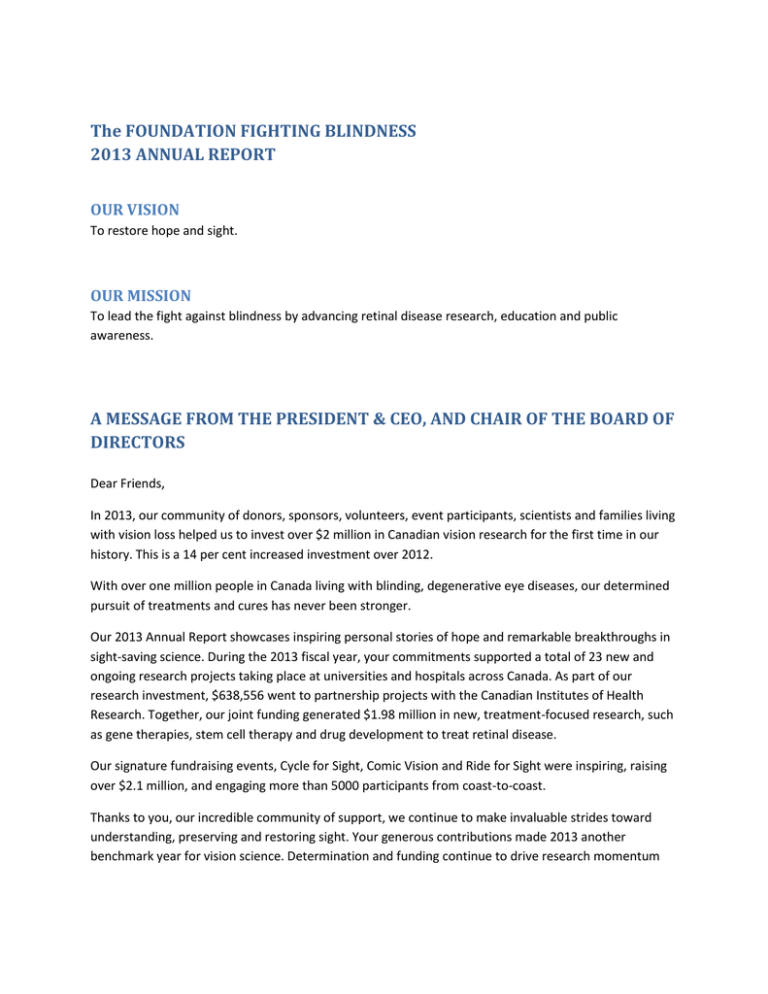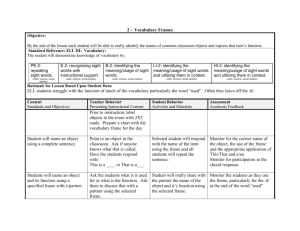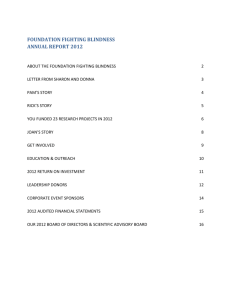DOC - The Foundation Fighting Blindness
advertisement

The FOUNDATION FIGHTING BLINDNESS 2013 ANNUAL REPORT OUR VISION To restore hope and sight. OUR MISSION To lead the fight against blindness by advancing retinal disease research, education and public awareness. A MESSAGE FROM THE PRESIDENT & CEO, AND CHAIR OF THE BOARD OF DIRECTORS Dear Friends, In 2013, our community of donors, sponsors, volunteers, event participants, scientists and families living with vision loss helped us to invest over $2 million in Canadian vision research for the first time in our history. This is a 14 per cent increased investment over 2012. With over one million people in Canada living with blinding, degenerative eye diseases, our determined pursuit of treatments and cures has never been stronger. Our 2013 Annual Report showcases inspiring personal stories of hope and remarkable breakthroughs in sight-saving science. During the 2013 fiscal year, your commitments supported a total of 23 new and ongoing research projects taking place at universities and hospitals across Canada. As part of our research investment, $638,556 went to partnership projects with the Canadian Institutes of Health Research. Together, our joint funding generated $1.98 million in new, treatment-focused research, such as gene therapies, stem cell therapy and drug development to treat retinal disease. Our signature fundraising events, Cycle for Sight, Comic Vision and Ride for Sight were inspiring, raising over $2.1 million, and engaging more than 5000 participants from coast-to-coast. Thanks to you, our incredible community of support, we continue to make invaluable strides toward understanding, preserving and restoring sight. Your generous contributions made 2013 another benchmark year for vision science. Determination and funding continue to drive research momentum and are bringing us closer than ever to treatments and cures for Canadians living with blinding eye diseases. Thank you, Sharon Colle, President & CEO Donna Green, Chair of the Board RESEARCHER FIGHTING FOR HIS SIGHT When Stuart Matan-Lithwick was 23 years old he was diagnosed with retinitis pigmentosa (RP), a progressive, blinding eye disease. Now, at 36, he is a PhD student researching retina cell biology – determined to find treatments and cures to restore vision. Before he was diagnosed with RP, Matan-Lithwick was passionate about science. “I love investigating things. It’s in my soul,” he said. But he thought losing his vision meant he could no longer pursue that dream. Instead he became a high school teacher, hoping to inspire others into a career of science. Then, an encounter with Dr. Valerie Wallace at Vision Quest, “one of the most monumental meetings” of his life, re-ignited his passion for scientific research. Vision Quest is an annual education event hosted by the Foundation Fighting Blindness. It brings together researchers and clinicians, with people living with vision loss, to learn about the latest retina research and socialize in a supportive community environment. “Hearing about Dr. Wallace’s research made me re-evaluate the notion that my eye disease was incurable. It planted a seed in me that my work was not yet done,” he said. Determined to help find treatments and cures for blindness, he chose to leave teaching and pursue a PhD as a member of Dr. Wallace’s research team at the Toronto Western Research Institute. This team is taking major steps to bring treatments to people living with blindness, including himself. “Dr. Wallace took me on knowing that I may not have my vision long enough to finish my PhD,” he said. “Not many people would have done that.” In return, Matan-Lithwick is doing all he can, while he can. Recently, Stuart’s doctor identified the gene mutation that causes his RP. Canadian scientists were involved in the discovery of this gene, and the information may help make Stuart eligible for a future trial of a stem cell based gene therapy. TACKLING STEM CELL CHALLENGES TO RESTORE SIGHT Stem cell transplants have amazing potential to restore vision to those who are blind. They are already being used in Canada to repair serious damage to the cornea of the eye. Now, conquering more complicated repairs to the light-sensing cells of the retina is next! In 2009, the Foundation Fighting Blindness partnered with the Canadian Institutes of Health Research on a five-year, $2.4 million project to push this science forward. Under the leadership of Dr. Valerie Wallace, these funds brought leading scientists from the Universities of Calgary, Ottawa and Toronto together. The team tackled some of the biggest challenges blocking stem cell success. While early studies had shown that transplants could restore some sight in animals, there are many technical challenges to upscale this advance for humans. We need ways to produce large numbers of pure cells, as well as better techniques to monitor transplanted cells and hold them in place until they can begin to function. This team came through with some exciting new advances. They developed a technique to produce retinal cells directly from skin cells, making the transplant process safer, and they also found ways to hold transplanted cells in place within the retina until they can grow and make sight-restoring connections. The team developed new tools to monitor cone cell transplants, launching a program of research in Dr. Wallace’s lab aimed specifically at cone cell transplants. Only 5% of the retina’s light-sensing cells are cone cells, but they are responsible for our precious central and colour vision. Transplants of these cells would provide a brighter future for people living with central vision loss, such as that caused by agerelated macular degeneration and Stargardt disease, and could also help people with advanced retinitis pigmentosa. SLOWING THE CLOCK ON VISION LOSS What if loss of vision could be slowed for years or even decades? Dr. Rod Bremner studies the complicated steps that lead to the development of retinal cells. This process is controlled by proteins called cell cycle regulators. His research is contributing to stem cell science to restore sight, but it may also offer important clues to protect light-sensing cells – potentially preserving vision for people with retinitis pigmentosa and other retinal diseases. Dr. Bremner observed that mice with retinitis pigmentosa had increased levels of E2f, a cell cycle regulator. He proposed experiments to see if blocking E2f could protect the light-sensing photoreceptors preserving vision. At first the results were disappointing. E2f did protect the photoreceptors, but the effect was modest and fleeting. Determined to find a more effective protection, Dr. Bremner soon partnered with Dr. Yvan Arsenijevic at Lund University in Sweden, who studied another protein (Bmi1) active earlier in the development of the eye. This time, inactivating the protein had a powerfully beneficial effect on photoreceptor survival. The discovery suggested that Bmi1 may be one of the body’s most important regulators of photoreceptor survival. This opens the door to developing a drug or therapy to inactivate this protein in humans, to protect photoreceptors and preserve sight. Therapies that enhance photoreceptor survival are called neuroprotective therapies. This is a Canadian research strength and the Foundation funds several teams working towards such therapies that potentially could extend a person’s functional sight for many years. DETERMINED TO SAVE THEIR CHILDREN’S SIGHT There are two words that Shelagh and Mark Anson wish no parent has to learn – Usher Syndrome. Eight years ago, their son Rowan was born, seemingly healthy. Or so they thought. But then they noticed he wasn’t hearing normally. Eventually they learned their baby had Usher Syndrome, Type I. Children with Type I are almost always born with no hearing at all. Then they begin to lose their sight during the first decade of life, eventually becoming blind. The Anson’s daughter, Caroline, was born one year after Rowan, with the same diagnosis. “I will not deny it. It was horrible to learn,” said Shelagh Anson. “Every parent wants their child to be perfectly healthy in every way, and I’m no different.” Thanks to research breakthroughs, Rowan and Caroline can “put their ears on” and hear via cochlear implants. But they need another discovery to save their vision. “Some days I wish I could stop time, and keep them this age forever, so they’d never have to worry about losing their sight,” said Shelagh. “But, as they say, time waits for no-one.” As a pediatrician, Shelagh understands that medical breakthroughs take time. Usher Syndrome, along with many other eye diseases, are under the microscope. Thanks to progress in Foundation-funded retinal research to preserve and restore sight, she is convinced that discoveries will come within the next 10 years, soon enough for her children to retain their sight. The Ansons support the Foundation as monthly donors and volunteer with Comic Vision, our comedy fundraiser, in Vancouver. They also allowed the Foundation to share their story through a fundraising appeal letter that has garnered close to 1,500 new donors and $37,000 for vision research. “I believe that research is an investment in hope, and some days it’s one of the only things that keeps me going,” Shelagh said. “We have a long way to go, but I am going to fight for my children’s vision and for the sake of so many others in danger of losing their sight, and I’m not going to give up. I cannot!” INVESTING IN WORLD-CLASS DISCOVERY Max Munday and Carolyn Bacon are brother and sister; both living with vision loss from Stargardt disease, the inherited form of juvenile macular degeneration. They are also both visionaries when it comes to investing in eye disease research. The Munday and Bacon families supported a multi-year, international research initiative through the Foundation Fighting Blindness, with the aim of tackling challenges in gene therapy for Stargardt disease. This research initiative was led by world-class researcher, Dr. Robert Molday at the University of British Columbia. Dr. Molday developed a $3 million research initiative to solve the problem of gene therapy for people with Stargardt disease. Gene therapy aims to reverse blinding disease by placing a healthy copy of a damaged gene into the cells of the retina. Gene therapies use a vector to carry a healthy gene into retinal cells. A vector called AAV was used successfully in the 2008 clinical trial for a type of Leber Congenital Amaurosis. AAV is proven to target the retina’s photoreceptors; unfortunately, it is also tiny and cannot carry the large Stargardt gene. Dr. Molday is research team made a groundbreaking discovery. They found a way to split the Stargardt gene in two so that AAV could carry it into a photoreceptor cell, and then reassemble it inside. This has opened the door to a gene therapy for people living with Stargardt disease using the proven AAV vector. Max and Carolyn’s parents were equally proud and excited about their family’s support of this research. This project was funded by the Foundation and matched by the Canadian Institute of Health Research, becoming the first joint partnership ever entered into between Canada’s funding agency and the Foundation. “CIHR was willing to contribute $2 for every dollar we gave,” says Foundation president, Sharon Colle, “but without the Mundays, we still could not have taken on this project. It was their vision and willingness to contribute that made it possible.” While the families are modest about their contribution, they hope this research milestone will inspire more donors to invest in research to bring us closer to treatments and cures than ever before. “It’s been a great privilege to be involved, even if it doesn’t necessarily help me or Carolyn right now. The greatest benefit will be that it will help future generations,” said Max. FUNDING RETINAL RESEARCH EXCELLENCE For the first time in our history, the Foundation Fighting Blindness invested more than $2 million in sight-saving research. Research grants were funded across Canada. BRITISH COLUMBIA (University of Victoria and University of British Columbia) Dr. Gautam Awatramani studies the use of light-sensing molecules to send visual signals directly to the electrical circuits of the retina Dr. Kevin Gregory-Evans’ team is testing combination therapies for retinal disease; funded in partnership with CIHR Dr. Perry Howard aims to increase production of photoreceptors for sight-saving transplants Dr. Robert Molday’s team studies gene therapy for Stargardt and other retinal diseases; a CIHR partnership Dr. Orson Moritz’s research aims to determine which types of retinitis pigmentosa might be most effectively treated with valproic acid ALBERTA (University of Alberta and University of Calgary) Dr. Ian MacDonald studies choroideremia, initiating Canada’s first clinical trial of a gene therapy for eye disease; supported in partnership with CIHR Dr. Bill Stell supervises the EYEGEYE Research Training Fund for promising vision research students ONTARIO (University of Toronto, McMaster University and Ottawa Hospital Research Institute) Dr. Rod Bremner studies the body’s regulatory proteins and how they might be used to preserve vision in retinitis pigmentosa Dr. Philippe Monnier evaluates a potential drug to help light-sensing photoreceptors survive Dr. David Picketts examines the response of retinal neurons to photoreceptor disease Dr. Vince Tropepe studies photoreceptor repair in zebrafish Dr. Catherine Tsilfidis’ team studies XIAP therapy to protect the retina; funded with CIHR. Dr. Derek van der Kooy studies new means of transplanting retinal cells into the eye; Dr. Saeed Khalili, also received a postdoctoral fellowship to train in this laboratory Dr. Valerie Wallace’s team works to improve the potential for sight-restoring stem cell transplants funded with CIHR. Dr. Judith West-Mays studies how genetic changes disrupt the eye’s development ATLANTIC CANADA (Memorial University) Dr. Bob Gendron studies potential therapies for wet AMD QUEBEC (Institut de recherches cliniques de Montréal, Hôpital Maisonneuve-Rosemont, Montreal Children’s Hospital and Jewish General Hospital). Dr. Gilbert Bernier works on transplants of cells to save central vision in people with Stargardt disease and AMD Dr. Michel Cayouette’s research aims to understand how photoreceptors are produced and how more might be made for sight-saving transplants Dr. Robert Koenekoop aims to identify the genes which cause different types of Leber congenital amaurosis and retinitis pigmentosa Dr. Bruno Larrivée studies a potential therapy for wet AMD Dr. Uri Sargovi evaluates drugs which may protect retinal cells Dr. Przemyslaw Sapieha studies the use of omega-3 fatty acids to make wet AMD therapy more effective RESEARCH RETURN ON INVESTMENT Partnerships The Foundation Fighting Blindness partners with government and other non-profit funders to create momentum in vision science. In 2013, we invested $638,556 in partnership projects, generating $1.98 million in new, treatmentfocused research; maximizing the impact of your donations. Donations supported 23 sight-saving projects in three categories: 1. Understanding Vision Loss (2 projects) 2. Preserving Sight (12 projects) 3. Restoring Sight (9 projects) Our emphasis on treatment-focused research is growing, with a surge of new projects working to protect and restore sight, including Canada’s first human trial of a gene therapy for inherited retinal disease. ENGAGING YOUNG LEADERS The Foundation engages people as Ambassadors for vision research in their community; 17 year-old, Jack McCormick, is one of them. In the summer of 2013, Jack was diagnosed with Leber’s Congenital Amaurosis. He was told that the vision loss he had been experiencing would eventually lead to blindness. “My largest fear was becoming a reality. I was losing my ability to see the uniqueness of every person’s face and the whole world around me,” said Jack. “I was terrified of the future and didn’t know how I would adjust to the change.” But Jack emerged from his fear and adopted a positive outlook. He remembered that the geneticist, who delivered his diagnosis, had mentioned the Foundation Fighting Blindness. In the fall, he set out to be Glendale High School’s Student Council Charity Minister so he could support the Foundation. In turn, the charity gave him tools and materials to help his efforts. He organized a school-wide talent show and a “Dinner in the Dark” fundraiser. He reached out to local businesses to secure donations of gift cards and other prizes, and secured free advertising on his local radio station and in his local newspaper in Tillsonburg, Ontario. Over 100 tickets were sold for the events, and over $2,000 was raised for sight-saving research. His efforts also increased awareness of eye disease amongst his classmates and teachers, and his community at large. “I think that it was important to my community because of the amount of passion I showed in organizing and advertising this event,” said Jack. “People understood how much it meant to me and how much it would mean if the event was a success, and it was.” Jack continues his role as a Youth Ambassador for the Foundation, promoting its Cause Partner Program to his local Opticians. OUR COMMUNITY The Foundation Fighting Blindness’ three signature fundraising events raised a combined total of $2.1 million and engaged 5,248 participants in 14 regions across Canada. Cycle for Sight, challenged people who are visually-impaired, and sighted individuals, to take on a cycling journey ranging from 50 to 140 km. “I felt privileged to ride with vision-impaired cyclists maeuvering the long course on tandem bikes with sighted partners,” said Marilyn Henderson, in her first year with Cycle for Sight. “It’s an incredibly inspiring and empowering day to be a part of.” Comic Vision, our comedy fundraising tour, attended by the corporate community and individuals who love to laugh. “Sponsoring Comic Vision was a great opportunity to invest in sight-saving research, while also raising our employees’ awareness of the Foundation and the work that they do,” said Jamie Davis, Bayer Inc. “We engaged our staff as attendees and volunteers as part of our commitment to community investment.” Ride for Sight, our motocycle fundraiser in its 35th year. “We raise money every year,” said Katie Vanderyt, whose daughter Meghan has retinitis pigmentosa. “It takes time and effort, and is very rewarding. Fundraising this way brings public awareness to retinal diseases and the Foundation. Your donations are so important to families like ours, so come on out to an event or write a cheque. Whatever you do, we appreciate your time and effort.” Vision Quest 2013, an education session that informs and inspires. Our Vision Quest education series visit Vancouver, London, Toronto and Ottawa. It’s the only national education program that connects individuals and families touched by vision loss directly with top vision experts to learn about the latest sight-saving research. Vision Quest also included sessions for youth in London and Ottawa. The annual sessions are unique opportunities to learn and socialize in a supportive environment. In 2013, over 900 people attended. 2013 LEADERSHIP DONORS Thank you to our generous Leadership Donors; individuals, corporations & foundations who made philanthropic gifts of $5,000 or more in 2013. Their loyal support helped the Foundation fund vital research to preserve vision and restore sight. $100,000+ Anonymous (1) Krembil Foundation $50,000-$99,999 Anonymous (2) Maxwell and Gaylene Munday $25,000-$49,999 Elizabeth and John Breen Jane Collins Crosstown Heating & Ventilating (Calgary) Ltd. Deeley Harley-Davidson Canada Donna Green Renate Greenwood Catherine and Greg Haverstock Ledcor Group of Companies RBC Foundation Dr. Bill and Kathie Stell $5,000-$24,999 Dorothy Adair Allergan International Foundation Anonymous Friends Anonymous (3) Anonymous (4) Anonymous (5) Anonymous (6) Arthur J.E. Child Foundation Dr. David and Rachel Baron Bayer Inc. Steve Beattie Estate of Ernest Bradshaw James Collins D+H Edmonton The City of Champions Lions Club Joe and Deborah Grech Ossie Hinds and Anne La Rocque Hotel Gander Malcolm Hunter Ron Lalonde and Jane Humphreys Gideon and Kari Leoganda Nancy MacKellar Leonard and Selma Martin Michael McCain Andrew and Shawna Merkur Florence Munday and Otis Munday Foundation Pallister Farm Ltd Estate of Jean Pettit Estate of Doreen Powles Cam and Michelle Robinson Marcelle Roy Rx&D Health Research Foundation Cookie and Stephen Sandler Shorcan Brokers Limited Pat and Bob Steele Dr. Raymond Stein and Nancy Viner Estate of Betty L. Stewart David and Donna Sweeny David and Deborah Tennant Trev Deeley Foundation 2013 CORPORATE EVENT SPONSORS We are proud to recognize our corporate partners generosity, commitment, and support of our annual fundraising events. Our corporate partners are essential to the success of our annual fundraising events. This list does not include organizations who donated generous gifts in-kind, or the Foundation’s promotional partners. $50,000-$99,999 Accessible Media Inc. Bayer Inc. Bell Bochner Eye Institute Novartis Pharmaceuticals (Canada) Inc. $25,000-$49,999 CIBC Deeley Harley-Davidson Canada KPMG Sirius XM Canada Inc. $5,000-$24,999 Alcon Canada Inc. AROGA Bausch + Lomb BMO Financial Group Broadridge Financial Solutions (Canada) Inc. Calgary Retina Consultants Credit Suisse Securities (Canada) Inc. Expedia Canada Corporation GAMMA Sales Inc. Gluskin Sheff + Associates Great Gulf Huawei Technologies Canada Co., Ltd. iCo Therapeutics Inc. Lakeside Ledcor Group of Companies Peller Estates Pengrowth Energy Corporation Raleigh Canada Jim Ritchie Samsung Shred-It TD Securities Inc. Yamaha Motor Canada MESSAGE FROM OUR TREASURER The determination and passion of our donors, volunteers and researchers continues to make the Foundation Fighting Blindness the largest supporter of sight-saving research in Canada. Through our funding, we’ve cultivated an influential community of retinal researchers whose impact is felt worldwide. This gives hope to more than one million Canadians living with blinding retinal eye diseases. Thanks to the generosity of our more than 26,250 donors and the commitment of our volunteers, our gross revenue in fiscal 2013 was $4.5 million, a steady increase over the past three years. As a result, funding to our research and education programs increased by 33% over this same period. From 2011 to 2013, the Foundation embarked on a three-year capacity building plan: “Investing in the Future.” The goal was to build the organization’s infrastructure to support and diversify revenue sources for the future. One focus was on the Major Gift program. In 2013, it continued to be our largest revenue source, accounting for $1.3 million, or 28% of total revenue. Our signature events, Comic Vision, Cycle for Sight, and Ride for Sight, remained significant sources of revenue. They engaged 600+ volunteers, 5,248 participants and generated more than 14,500 donations across 14 regions of Canada. However, our overall revenue targets were not met by fundraising events and expenses increased slightly. Some expense was due to investment in staff; a return which we expect to see in future years. Our education series, Vision Quest, continues to be one of our most vital programs, reaching over 900 people touched by retinal diseases in four cities across Canada in 2013. Our administration costs increased slightly to ensure we have the resources for future growth. Our fiscal deficit was planned, as it has been over the past few years, as we drew on unrestricted funds to increase investment in research and other mission priorities. As we look ahead, we’re confident the impact of the research we fund will translate into new treatments for eye diseases, thanks to our loyal and new supporters. Rahn Dodick, Treasurer 2013 FINANCIALS REVENUES Fundraising Events Gifts & Bequests Investment/Interest Total MISSION Research Education Total EXPENSES Administration Fundraising Events Direct Fundraising Total 2013 2,244,181 2,122,595 193,669 4,560,445 2013 2,081,017 342,556 2,423,573 2013 973,754 1,044,967 582,035 2,600,756 2012 2,233,276 2,019,825 148,697 4,401,798 2012 1,829,940 344,607 2,174,547 2012 855,764 911,071 491,506 2,258,341 SOURCES OF REVENUE Major Gifts Comic Vision Other Gifts Ride for Sight Cycle for Sight Investment + Other 28% 21% 18% 15% 12% 6% OUR 2013 BOARD OF DIRECTORS The Foundation Fighting Blindness is overseen by a board of outstanding and committed individuals. Our board governs major decisions, approves research grants, and provides direction for organizational practices. EXECUTIVE COMMITTEE & OFFICERS Donna Green, Chair John Breen, Vice Chair Rahn Dodick, Treasurer Andrew Burke, Corporate Secretary Catherine Tillmann, Executive Officer Joe Grech, Executive Officer DIRECTORS David Drury Sherif El-Defrawy, MD, PhD, FRCSC Kevin Gregory-Evans, MD, PhD, FRCS, FRCOphth Jane Humphreys Malcolm Hunter Peter J Kertes, MD, CM, FRCSC Gary Mandel Michael Ovens Lorna L Rosenstein Raymond M Stein, MD, FRCSC David D Sweeny Deborah Tennant Valerie Wallace, PhD Sharon M Colle, President & CEO, ex-officio OUR 2013 SCIENTIFIC ADVISORY BOARD Our SAB is comprised of exceptional scientists actively engaged in sight-saving research. They provide volunteer scientific leadership, evaluate research grant applications, and support our education programs. Michel Cayouette, PhD, Chair Rod Bremner, PhD Robert Gendron, PhD Ordan Lehmann, MD PhD Brian Link, PhD Orson Moritz, PhD William Stell, MD, PhD, Ex-officio RESEARCH AND ADVOCACY TASKFORCE In preparation for our 40th anniversary, the Foundation convened a taskforce of clinicians, donors, board members, volunteers and people living with retinal disease. They evaluated our research progress over the past 40 years and made recommendations to our Board to ensure that research benefits Canadians in the next 10 years. Michael Brent, MD John Breen Andrew Burke Michel Cayouette, PhD Ossie Hinds David Jones, PhD Lori Lyons Nancy MacKellar Michael Ovens William Stell, MD, PhD Valerie Wallace, PhD In turn, the task force sought advice from two groups of experts: EXPERT ACADEMIC REVIEW PANEL Scientific leaders in vision research who reviewed our scientific progress. Rod McInnes, MD, PhD – Director, Lady Davis Institute, Jewish General Hospital Kym Boycott, MD, PhD – Geneticist, Children’s Hospital of Eastern Ontario (CHEO) Eric Pierce, MD, PhD - Associate Director, Berman-Gund Laboratory, Harvard PUBLIC POLICY SUB-COMMITTEE Policy experts who offered specialized advice on advocating for treatments and research. Kevin McGuire Michael Ovens Lorna L. Rosenstein Mark Smythies Amelia Swanson







